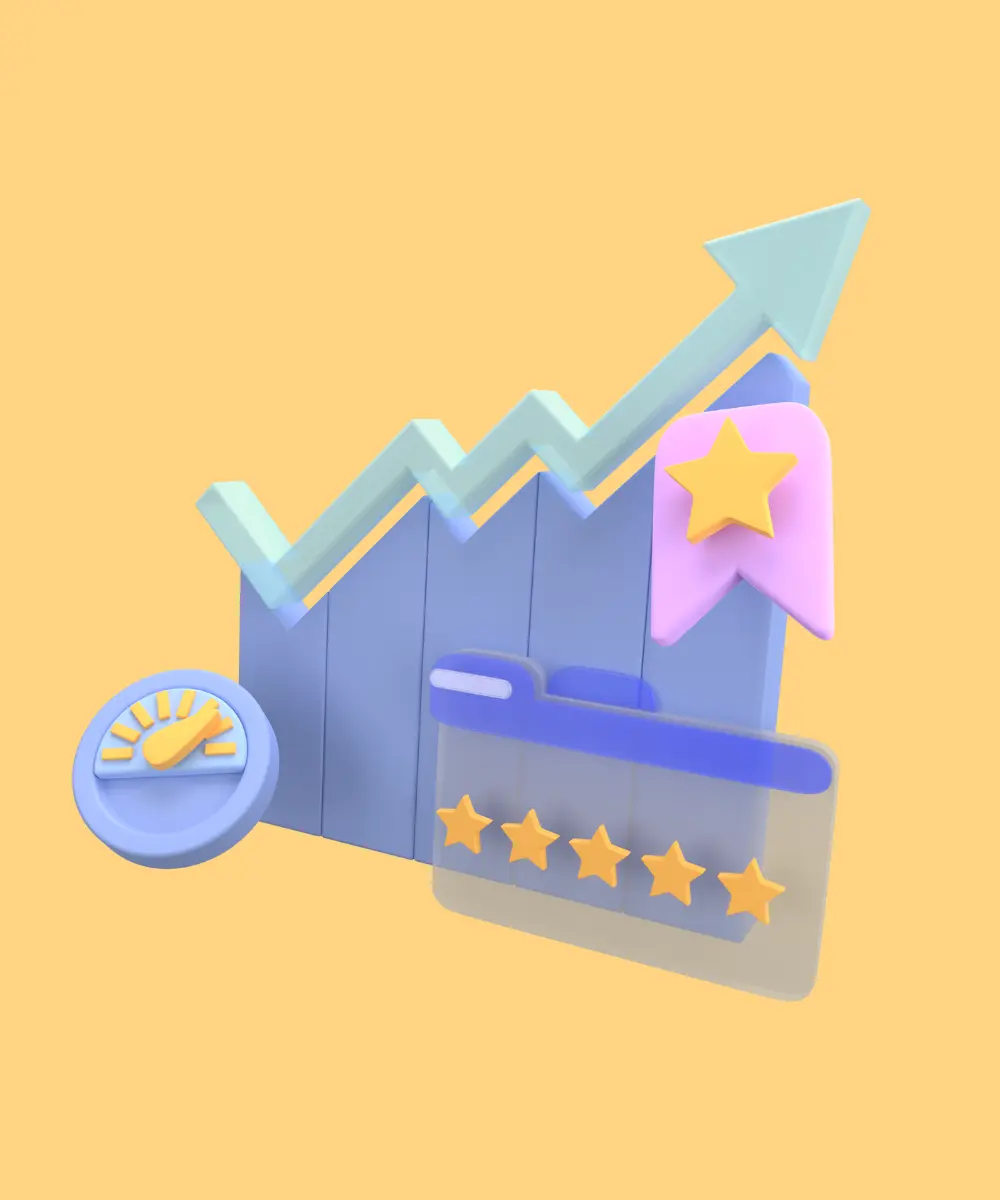Introduction
In the dynamic realm of mobile app development, the concept of scalability stands as a pivotal element for success. With over 3.5 billion smartphone users worldwide and an ever-growing app market, the capacity of an application to scale effectively is integral to its longevity and relevance. Scalability transcends being a mere technical feature; it's a strategic imperative in a market driven by rapidly evolving user expectations and advancing technology.
This exploration into scalability in mobile app development delves into its critical importance, methods for estimating scalability, the advantages of scalable applications, and essential strategies to mitigate scalability issues. As we unpack these concepts, the focus will be on understanding how scalability is not just about handling growth but also about preparing for it, ensuring that applications remain robust and efficient in an increasingly digital world.
What Is Scalability In App Development?
Scalability in the realm of app development is a multifaceted concept, central to the architecture and long-term viability of mobile applications. It refers to an application’s ability to efficiently and effectively handle an increase in workload without compromising on performance or user experience. This increase could stem from a surge in user numbers, a growth in data, or an uptick in transaction volume.
Core aspects of scalability
In the mobile app domain, scalability must consider various factors such as:
- User growth: How well the app performs as the user base increases, particularly in handling concurrent users.
- Data volume: The app’s ability to manage increasing amounts of data, which includes user data, transaction records, or multimedia content.
- Feature expansion: As an app evolves, it often requires new features and functionalities. A scalable app should be able to integrate these enhancements smoothly.
- Cross-platform efficiency: Especially pertinent for frameworks like Flutter, scalability also means maintaining performance across different platforms and devices.

Types of scalability
Understanding the different dimensions of scalability is crucial:
- Horizontal scalability: This involves expanding capacity by connecting multiple hardware or software entities so that they work as a single logical unit. When an app scales horizontally, it might involve adding more servers or instances to manage the load. This is often easier to implement and more flexible, as it allows for scaling out resources according to demand.
- Vertical scalability: Vertical scaling, on the other hand, means increasing the capacity of existing systems or servers, like upgrading a server with a larger hard drive or more memory. It’s often limited by the fact that you can only upgrade a system to a certain extent.
Why Does Scalability Matter?
Scalability in app development is more than a technical specification; it's a critical component that can make or break the success of an application in today's fast-paced digital ecosystem. As mobile app usage continues to surge, with over 200 billion downloads recorded annually, the ability of an app to scale becomes a defining factor in its sustainability and growth.
Enhancing user experience
- Performance under pressure: Scalability ensures that an app remains fast and responsive, even during peak usage times. This is vital in maintaining user satisfaction, as even a slight delay can lead to significant user drop-off rates.
- Seamless user journeys: A scalable app can handle increased user interaction without glitches or downtime, providing a smooth, uninterrupted user experience.
Supporting business growth
- Adapting to market changes: Scalable apps can swiftly adapt to changing market demands, whether it’s a sudden surge in user numbers or the integration of new features.
- Cost-effective scaling: By planning for scalability from the start, businesses can avoid the excessive costs associated with retrofitting an app to handle unexpected growth.
- Competitive advantage: In a market where user expectations are high, having a scalable app can be a significant competitive edge, offering reliability and better performance compared to less scalable counterparts.
Data and analytics
- Handling increasing data volumes: As user numbers grow, so does the volume of data generated. Scalable apps can manage and analyze this data effectively, providing valuable insights into user behavior and app performance.
- Data-driven decisions: The ability to process and interpret large data sets enables businesses to make informed decisions, enhancing the app based on real user data and trends.
Long-term viability
- Future-proofing: Scalability is about preparing for the future. It ensures that as technology advances and user habits evolve, the app can evolve too, without the need for complete redevelopment.
- Sustainability: Scalable apps are more sustainable; they use resources efficiently and can grow without a proportional increase in costs or resources.
How Do You Estimate Scalability In Mobile App Development?
Estimating scalability is a critical step in the app development process, ensuring that the app not only meets current demands but is also prepared for future growth. This estimation is a complex process that involves analyzing several factors to determine how well an app will perform as it scales.
Understanding user growth and traffic patterns
- User growth forecasting: Analyzing current user trends and market data to predict future growth. This includes understanding the target audience and potential market size.
- Traffic analysis: Estimating the peak traffic the app might experience, taking into account factors like seasonal spikes or marketing campaigns that could lead to sudden increases in user numbers.
Analyzing technical requirements
- Resource utilization: Evaluating the app’s resource usage under different load scenarios. This includes assessing CPU, memory, and network bandwidth requirements as user numbers grow.
- Database scalability: Assessing how the app’s database will handle increased data volume. This involves looking at aspects like data structure design, query optimization, and database management systems.
- Third-party services and dependencies: Understanding the scalability limitations of any third-party services or APIs the app relies on.
Performance testing
- Load testing: Simulating various user loads to observe how the app behaves. This helps in identifying potential bottlenecks and areas that need optimization.
- Stress testing: Pushing the app to its limits to see at what point it breaks. This provides insights into the maximum capacity of the current app architecture.
Scalability metrics
- Response time: Measuring how long it takes for the app to respond to user requests under different load conditions.
- Concurrent users: Determining the maximum number of users that can simultaneously use the app without performance degradation.
- Throughput: Assessing the number of transactions or actions the app can handle per unit of time.
Continuous monitoring and iteration
- Ongoing monitoring: Regularly tracking the app’s performance post-launch to identify scalability issues as they arise.
- Iterative scaling: Continuously improving the app based on real-world usage data and performance metrics.
What Are the Benefits of Building Scalable Applications?
Building scalable applications is not just a technical endeavor; it's a strategic business decision that yields significant long-term benefits. Scalable applications are designed to grow with your business, accommodating increasing user demands and data volumes without sacrificing performance. Here are the key benefits, illustrated with real-world examples:
Enhanced user satisfaction and retention

Scalable apps deliver a consistent user experience, even under heavy load, reducing user frustration and abandonment. X (former Twitter), a platform with millions of concurrent users, exemplifies this by efficiently managing high traffic volumes, especially during significant global events, maintaining smooth user experiences.

Cost efficiency and resource optimization
Scalability allows for efficient use of resources, which can be dynamically allocated based on demand. Amazon Web Services (AWS) is an excellent example of this. AWS offers scalable cloud services, allowing businesses to pay for only what they use. This scalability ensures cost-effectiveness and the efficient use of resources.
Increased revenue opportunities
Scalable apps can capitalize on unexpected surges in traffic, such as during promotional events or viral trends, turning potential customers into actual users. E-commerce platforms like Amazon demonstrate this during events like Black Friday or Prime Day, where their scalable infrastructure handles sudden spikes in traffic and transactions, leading to increased sales.
Flexibility and speed in market adaptation
Scalable applications can swiftly adapt to market changes, giving businesses a competitive edge. A notable example is Instagram. Initially a simple photo-sharing app, Instagram’s scalable architecture allowed it to quickly evolve, adding features like Stories, Reels, and e-commerce integration, thereby staying relevant and competitive.

Agility and competitiveness
Scalable apps can quickly adapt to market changes, new user requirements, or technological advancements, keeping businesses competitive. The gaming industry, with apps like Fortnite, showcases agility by continuously updating content and features to retain user interest while managing an expanding global user base.
Improved data management and analytics
Scalability allows apps to manage increasing volumes of data, enabling better user analytics and data-driven decision-making. Social media giants like Facebook manage vast amounts of user data daily, using scalable systems to analyze and utilize this data for targeted advertising and content curation.
Sustainability and future-proofing
Scalable applications are more sustainable, reducing the need for frequent major overhauls as technology evolves. Google’s suite of applications, including Google Maps and Gmail, have evolved over the years, accommodating growing user bases and functionality without significant downtime or performance issues.
Supporting business growth and innovation
Scalable apps align with a business's growth trajectory, supporting expansions and new initiatives. LinkedIn, which started as a professional networking site, scaled its platform to include job listings, learning resources, and more, supporting its growth and diversification strategy.
Global reach and market expansion
Scalable apps can cater to a global audience with varying demands. Spotify, a global music streaming service, uses a scalable architecture to manage its vast library and user base, offering seamless service across different regions and accommodating various user behaviors and preferences.

Preventing Scalability Issues: Plan from the Beginning
Addressing scalability at the outset of app development is crucial for preventing potential issues as the application grows. This proactive approach not only ensures smoother scaling but also significantly reduces the time and cost associated with making adjustments later. Here are key strategies to incorporate scalability from the beginning:
Scalable architecture design
- Modular architecture: Implement a modular design that allows for easy addition or modification of features without affecting the core functionality.
- Microservices aproach: Consider using microservices, which divide the app into smaller, independent services that can be scaled individually.
Choosing the right technology stack
- Scalable frameworks: Opt for frameworks known for their scalability, like Flutter, which allows for efficient cross-platform development.
- Database selection: Choose a database that can handle growth, considering factors like data structure, query efficiency, and scaling capabilities.
Efficient resource management
- Load balancing: Implement load balancing to distribute traffic evenly across servers, preventing overload on any single resource.
- Auto-scaling solutions: Utilize cloud services that offer auto-scaling features, automatically adjusting resources based on current demand.
Focusing on performance optimization
- Code efficiency: Write clean, efficient code with scalability in mind, avoiding practices that could lead to bottlenecks as user numbers increase.
- Caching strategies: Implement effective caching to reduce database load and improve response times.
Regular testing and monitoring
- Continuous testing: Regularly test the app under various load conditions to identify and fix scalability issues early.
- Performance monitoring: Use monitoring tools to track the app's performance in real-time, allowing for quick adjustments when needed.
Incorporating user feedback
- User-centric design: Regularly gather and analyze user feedback to understand their needs and adjust the app accordingly.
- Iterative development: Adopt an iterative development approach, continuously refining the app based on user feedback and performance data.
Planning for data growth
- Data scalability strategies: Plan for data growth with scalable storage solutions and efficient data handling practices.
- Big data technologies: Consider integrating big data technologies for handling and analyzing large data sets effectively.
Conclusion
In the rapidly evolving landscape of mobile app development, the significance of scalability cannot be overstated. It is the cornerstone of modern app architecture, crucial for ensuring that applications not only survive but thrive in the competitive digital marketplace. Scalability is about foresight and flexibility; it's about building an app with the potential to grow, to embrace change, and to withstand the test of time and technology.
What the Flutter is dedicated to crafting scalable, robust Flutter-based mobile applications that stand the test of time. Our expertise ensures that your app is not just ready for today's challenges but is also equipped for tomorrow's opportunities.
If you're looking to develop a mobile application that embodies flexibility, efficiency, and future-readiness, What the Flutter is your ideal partner. Contact us today, and let's embark on a journey to transform your vision into a scalable and successful mobile application. Together, we can shape the future of your digital presence.











